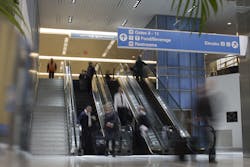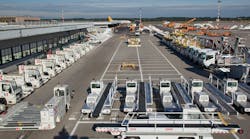Without air service, there’s no reason for airports to be in business. So facilities large and small have put aside resources to go after all-important flights and maintain existing service.
That task has gotten harder in the past 10 years as airlines have merged, gotten rid of smaller regional jets and turboprop aircraft and reduced capacity. Airline planners have raised the bar on how they choose air service, resulting in more airports chasing after a smaller piece of the pie. Representatives from large, medium and small airports share their successes and challenges with air service development.
Kristie Van Auken, who at the time this story was written was senior vice president and chief marketing and communications officer at Ohio’s Akron-Canton Airport, located about 50 miles south of Cleveland-Hopkins International Airport. “The consolidation of the airline industry has really shaped the air service picture for airports in our region, and both airports have been affected by consolidation,” she said. “We were also affected by the merger of Southwest and AirTran, and now the reduction of our service on Southwest.”
But the airport has also had some really good wins, said Van Auken. “That's the nature of this industry, particularly if you're not at a megahub. You're not going to win every time,” she said. “This year is going to be a painful year for us. But at the same time, in the last 12 months, we've been able to secure non-stop service to two New York City airports, which was really exciting for us. That was a key market that we wanted to replace after Southwest decided to leave that market.” The airport now has service on United Airlines to Newark and LaGuardia Airport on American Airlines.
The key for Akron Canton Airport is to focus on the fundamentals, said Van Auken. “Those fundamentals are offering deep knowledge of our local market to help airlines become successful faster in Akron Canton than other markets,” she noted. “We have to aggressively pursue the airlines that are still standing. Our competition is the 420 commercial airports across the U.S.”
Those airports all want to be the next best opportunity, said Van Auken. “For us to position ourselves to get that next best opportunity, we have to be smarter and be a little hungrier. And we have to go in with some unique propositions,” she said. “We feel our low-cost structure, our deep partnership mentality and ourmarketing knowledge is a powerful story is that everyone really likes.”
Mark Kiehl is the air service development manager for Norman Y. Mineta San José International Airport. “Travel patterns don’t typically change a lot over a five-year period. But if there’s one thing that is identifiable here, it’s that there’s probably an even greater global reach for our Silicon Valley companies,” he said. “And I think that’s why you’re seeing us go from two to seven international airlines in the span of about a year. If those markets weren’t important and high-profile, then the carriers wouldn’t be responding.” In the past year, Mineta Airport has won new service from China’s Hainan Airlines, British Airways, Lufthansa, Air Canada, ANA and Mexico’s Volaris.
Kiehl said that he’s been through several airline mergers. “If you look at the big three today, American, Delta and United, there’s probably at least 30 other carriers behind those brands because of all the mergers and acquisitions,” he noted. “It means that the pool has gotten smaller, which means that choices are fewer. That means that airports have to be much more targeted and more of a proactive partner with carriers and build your plan accordingly.”
San Jose is fortunate to have so many air service stories to tell right with the growth of international and domesticcarriers, said Kiehl. “The traditional way to do air service is tactical, where you approach an airline and talk about a specific route that might have an opportunity for new or expanded service,” he pointed out. “But when I got here, I took more of a strategic approach with carriers, so we are really moving forward both domestically and internationally. We hold out our new international routes as successful. But a domestic route is every bit as important to us, and is every much as successful for us too.”
San Jose is not the only airport in the region, with San Francisco International, Oakland International and even Sacramento International. “So as the crow flies, all those airports are not too far off. But when you are sitting in traffic for two hours from here in the South Bay trying to get to the North Bay area, that’s not so fun, especially in the morning when you have a flight to catch,” said Rosemary Barnes, San Jose Airport’s Public Information Manager. “We are very much focused on the convenience that our airport offers. Customers are able to get to their gates within a reasonable amount of time.”
Jim Tyrrell is the deputy director of business development for Philadelphia International Airport, a hub for American Airlines. “We went from a being a Star Alliance hub with US Airways to a oneworld hub under American,” he said. “So while we still have the same amount of international traffic, it connects differently.”
Because of industry consolidation, there are a lot less airlines to visit, said Tyrrell. “The interesting thing is not only the consolidation among the legacy carriers, but also the recent prosperity of the low-cost carriers,” he said. “Philadelphia has seen a fairly healthy growth in the last year, and quite frankly, it’s been attributable to low-cost carriers.”
Despite its hub status with American Airlines, Philadelphia is still campaigning hard for new and expanded flights. “Most recently, we were successful in bringing Qatar Airways with daily service,” said Kiehl. “That was a big deal for us. Qatar is a oneworld carrier that has been looking to make inroads into the U.S. market. It’s our first Gulf region air carrier.”
The Qatar Airways service was important because of connectivity, said Tyrrell. “We have a huge Indian population. We couldn't get there from here without somewhere to launch to Asia. Even though the Qatar flight doesn't have great connectivity to the Indian market, it has geographic connectivity and a great level of service from Doha to India.”
Alaska Airlines has added some new routes that we’re happy about, said San Jose’s Kiehl. “They are very symbolic because they not only bring some additional competition to the market, but they show that carrier’s commitment to the Silicon Valley,” he said. “If you look at our portfolio, you see double-digit growth with Alaska, with American and with Delta. We’ll add to that [service] list, and every one of them is important.”
Domestic service is important, said Kiehl. “We try to make sure our team understands that too. That’s the backbone of most airports in this country, so we have to really be careful and pay attention to that,” he said.
San Jose’s Barnes is part of a team of 10 that handles marketing and promoting at her facility. “We get the word out in the community about all our new service, announcements and launches. We also have a great team of consultants and great business associates in Silicon Valley that are so supportive of us,” she said. “Significant partners at the table include the Silicon Valley Chamber and the Silicon Valley Leadership Group, an agency that represents many of the high-tech CEOs here in Silicon Valley.”
They are at the table with the airport courting these airlines, announcing new service and launching these new flights, said Barnes. “They also go out on the delegations with us to help evangelize about Silicon Valley and our airport at those down-line destinations,” she said. “We also have the Silicon Valley Business Travel Association, a group of travel managers that represent a lot of companies here. But also at the table are airlines, hotels and tourism leaders. So we have a lot of support in the business community and certainly in our awesome team here.”
In looking at the rest of the year, each airport has different goals. “The most important one for us was Orlando. We've had nonstop service to Orlando ever since I've been at the airport, and I've been here for almost 20 years,” she said. “Since Southwest decided to exit that market, it was the number one priority. And thankfully, Allegiant is stepping in. They're going to provide nonstop service twice a week year round. So it's not daily, but it is low-fares and it's really well planned in time for vacation travelers.”
The airport would love to get service a little further west, to Chicago, said Van Auken. “That is a key priority now for us as we move forward. But with that being said, we can’t really move on to the next big objective until we are sure that what we have now will be successful,” she said. “So we have to exercise some patience and some discipline.”
San Jose Airport is humbled by the growth that its having, said Kiehl. “So a lot of this year is focused on the launch of these new and expanded services,” he said. “It takes a lot of team effort here to not only get these airlines launched, but we’ve got additional announcements coming up, which is almost a full-time activity all by itself.”
But there’s still a very high level of demand for service to the East Coast, said Kiehl. “If you look at the traditional markets, it’s Boston, Austin, Seattle, New York and Washington, D.C., as clear targets. And Atlanta is important too, along with Raleigh and Charlotte, North Carolina,” he said. “As the Silicon Valley expands, more and more companies need to have a presence here. If you came here and we took you for a drive, you would see companies represented that you think would be based here.”
Philadelphia has three air service goals for 2016: Asia, Asia and Asia, said Tyrrell. “It's one of the fastest-growing market in terms of airline capacity. We are the largest metropolitan area in the United States without direct service to Asia,” he said. “My business community is absolutely screaming that they want service to Asia.”
Beijing and Seoul would be nice, and they both have fabulous airports, said Tyrrell. “One thing we fully understanding and recognize is an air carrier’s commitment doing a route of the magnitude of Philly-Beijing or Philly-Seoul,” he said. “So in order to fly a Philly-Seoul or Philly-Beijing, an air carrier would have to commit close to three aircraft to fly that route. And the aircraft flying that route are about $500 million each, so we're talking about a commitment of an air carrier to over $1 billion in terms of the investment to fly this route. We know that is a huge commitment and we want to make sure that it's sustainable.”
In order to sustain that kind of investment of an air carrier, an airport has to have a pretty damn good business case, said Tyrrell. “So we make sure we do the due diligence that's necessary in terms of identifying why it makes sense for the carrier to commit the magnitude of those assets to Philadelphia,” he explained. “We show them how many passengers that they can expect with each leg of the trip we're able to commit it. We go through a lot in terms of carrying a presentation when we get the opportunity to do so.”
It's not about trying to buy an air carrier for flights in Philadelphia for a specific period of time, said Tyrrell. “I’ve seen it done at other airports. But we have to make sure it's sustainable, because we're each making a huge investment, not just the airline,” he said.


